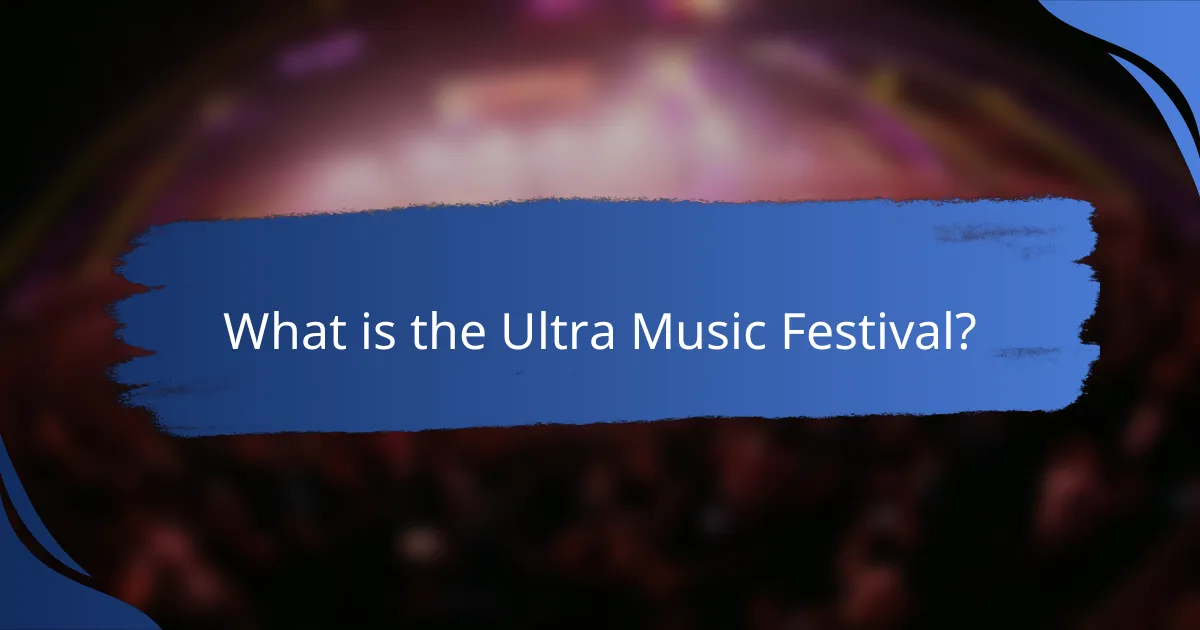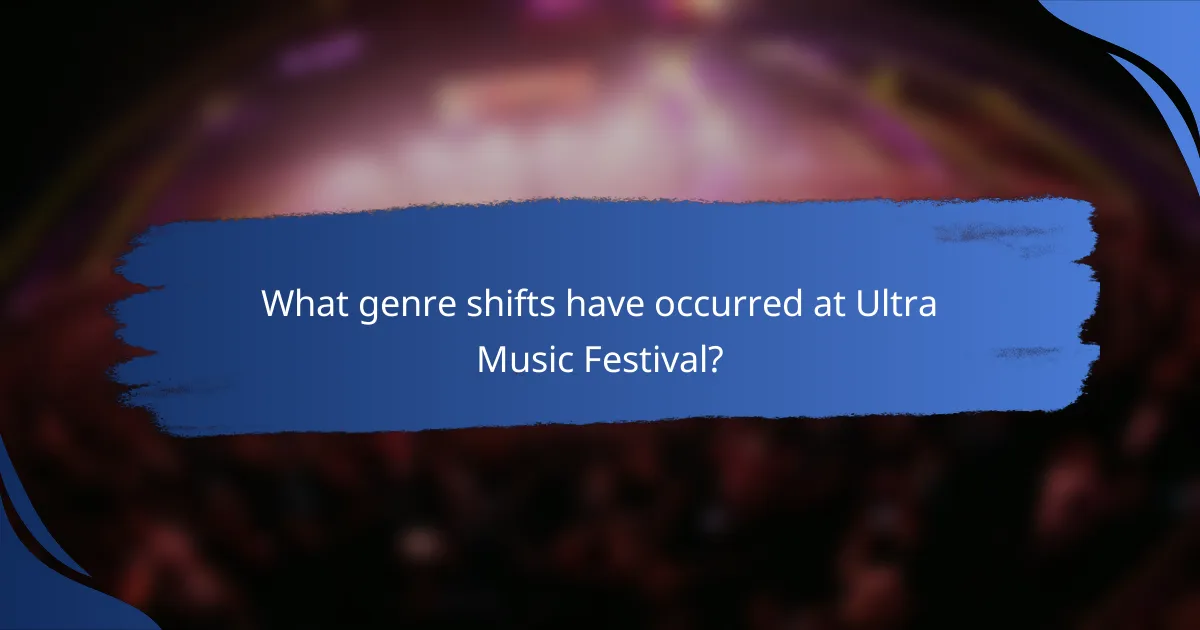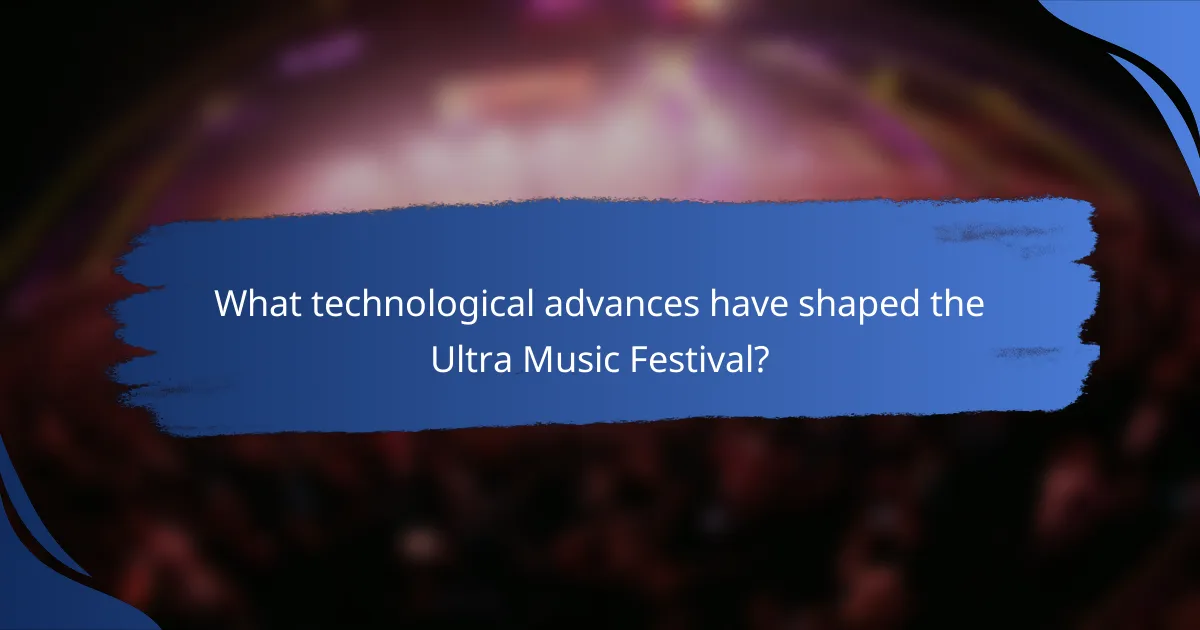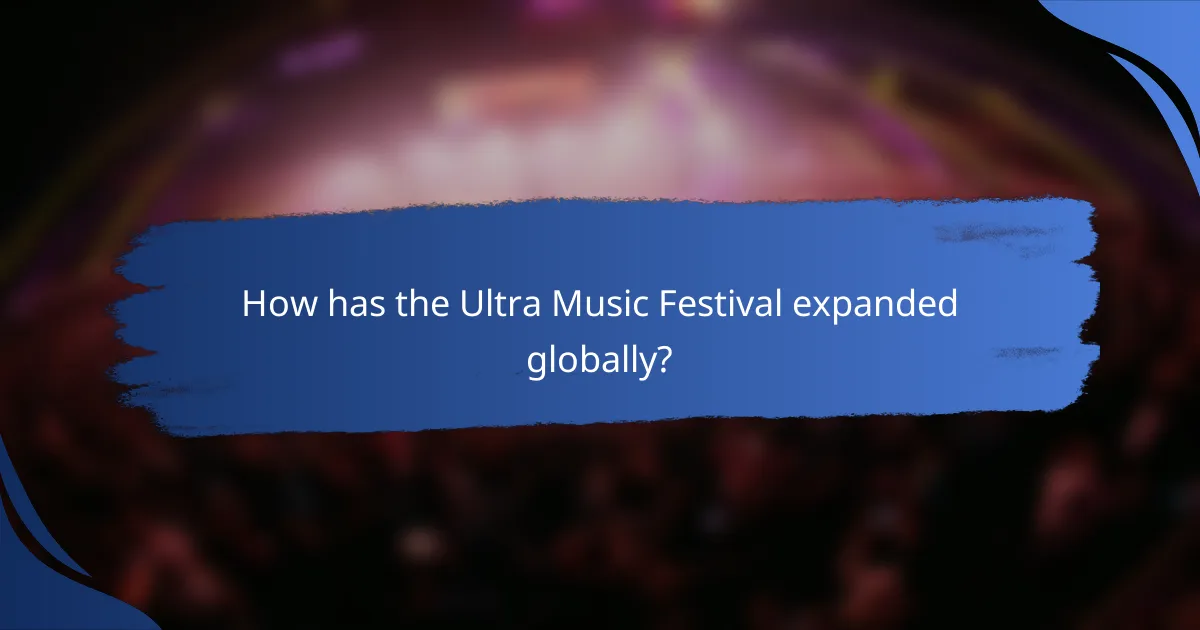The Ultra Music Festival is an annual electronic dance music event held in Miami, Florida, since its inception in 1999. This festival showcases a wide range of electronic music genres, including house, techno, trance, dubstep, and trap, reflecting the evolving tastes of its audience. Over the years, the festival has experienced significant growth, attracting hundreds of thousands of attendees and expanding its global presence to over 20 countries. Technological advancements, such as high-definition visuals, enhanced sound systems, and live streaming capabilities, have elevated the festival’s production quality and audience engagement. This article provides a comprehensive timeline of the Ultra Music Festival, detailing its genre shifts, technological innovations, and global expansion.

What is the Ultra Music Festival?
The Ultra Music Festival is an annual electronic dance music festival. It takes place in Miami, Florida. The festival was founded in 1999. It showcases various genres of electronic music. Artists from around the world perform at this event. The festival has grown significantly over the years. It attracts hundreds of thousands of attendees each year. Ultra Music Festival is known for its elaborate stage designs and high production value.
How did the Ultra Music Festival begin?
The Ultra Music Festival began in 1999. It was founded by Russell Faibisch and Alex Omes in Miami, Florida. The first event took place on March 13, 1999, at Collins Park. Initially, it was a one-day event featuring a small lineup of electronic music artists. The festival’s success led to its expansion into a multi-day event in subsequent years. By 2001, the festival had already gained significant popularity, attracting larger crowds. The Ultra Music Festival has since evolved into one of the largest electronic music festivals in the world. Its growth has been marked by diverse lineups and global expansion into various countries.
What were the initial goals and vision of the festival?
The initial goals and vision of the festival were to create a premier electronic music event. The founders aimed to showcase top DJs and artists in a vibrant atmosphere. They envisioned a platform for music lovers to connect and celebrate electronic music culture. The festival sought to provide an unforgettable experience through high-quality production and immersive performances. This vision has been supported by the festival’s growth and global recognition since its inception in 1999.
Who were the key figures involved in its inception?
The key figures involved in the inception of Ultra Music Festival are Russell Faibisch and Alex Omes. They founded the festival in 1999 in Miami, Florida. Their vision was to create a platform for electronic music artists. The first event attracted around 10,000 attendees. It featured prominent DJs and electronic music acts. Faibisch and Omes aimed to celebrate the genre’s growing popularity. Their efforts laid the foundation for future expansions of the festival. Ultra Music Festival has since become a global phenomenon.
What are the core elements that define the Ultra Music Festival?
The core elements that define the Ultra Music Festival include its location, lineup, and production quality. The festival takes place annually in Miami, Florida. It features a diverse lineup of top electronic dance music artists. Notable performers have included David Guetta and Tiësto. The production quality is renowned for its elaborate stage designs and visual effects. The festival also emphasizes a vibrant atmosphere, attracting fans from around the world. Additionally, it has expanded to various international locations since its inception in 1999. These factors collectively contribute to its reputation as a premier electronic music festival.
How does the festival’s location impact its identity?
The festival’s location significantly impacts its identity by shaping its cultural context and audience engagement. Ultra Music Festival, held in Miami, reflects the city’s vibrant nightlife and diverse music scene. The urban environment influences the festival’s atmosphere, attracting a global audience. Miami’s reputation as a party destination enhances the festival’s appeal. The location also allows for unique collaborations with local artists and businesses. Additionally, the warm climate enables outdoor events, contributing to the festival’s energetic vibe. Historical ties to electronic music in Miami further solidify the festival’s identity. Overall, the location is integral to the festival’s branding and success.
What genres of music are prominently featured at the festival?
The festival prominently features electronic dance music (EDM) genres. These include house, techno, trance, and dubstep. The lineup showcases both mainstream and underground artists. Historical data indicates that these genres have defined the festival’s identity. Over the years, the festival has adapted to include emerging sub-genres. This evolution reflects broader trends in the music industry. The festival attracts a diverse audience, enhancing its appeal. Its genre diversity contributes to its global recognition.

What genre shifts have occurred at Ultra Music Festival?
Ultra Music Festival has experienced significant genre shifts since its inception in 1999. Initially, the festival focused primarily on house music and techno. Over the years, it has expanded to include a diverse range of electronic dance music genres. Notable additions include trance, dubstep, and future bass.
In the early 2010s, the rise of big room house and electro house became prominent. This reflected broader trends in the electronic music scene. The festival has also showcased artists from hip-hop and pop genres, further diversifying its lineup.
By 2020, Ultra began featuring genres like trap and bass music more prominently. These shifts mirror the evolving tastes of festival-goers and the music industry as a whole. The festival continues to adapt, ensuring it remains relevant in the ever-changing landscape of electronic music.
How have musical genres evolved at the festival over the years?
Musical genres at the festival have evolved significantly over the years. Initially, the festival focused primarily on electronic dance music (EDM) genres like house and trance. In the early 2000s, the lineup began to diversify with the inclusion of techno and progressive house artists. By the mid-2010s, genres such as dubstep and trap gained popularity, reflecting broader trends in the music industry. The festival also embraced live performances, incorporating rock and pop elements into its lineup. Recent years have seen a rise in hybrid genres, blending EDM with hip-hop and world music influences. This evolution mirrors the changing tastes of festival-goers and the global growth of electronic music. The festival’s adaptability has allowed it to remain relevant and influential in the music scene.
What were the dominant genres in the early years?
The dominant genres in the early years of the Ultra Music Festival were electronic dance music (EDM), house, and techno. These genres defined the festival’s identity during its inception in 1999. House music, characterized by its repetitive beats and synthesized sounds, was particularly influential. Techno, with its roots in Detroit, also played a significant role in shaping the festival’s atmosphere. The early years saw prominent DJs and producers from these genres perform, attracting a dedicated audience. The festival’s focus on these genres helped establish its reputation in the electronic music scene.
How has the inclusion of new genres influenced the festival’s audience?
The inclusion of new genres has significantly broadened the festival’s audience. By incorporating diverse musical styles, the festival attracts fans from various backgrounds. This expansion leads to increased ticket sales and attendance figures. For example, the introduction of genres like trap and techno has drawn younger demographics. Studies show that festivals embracing genre diversity see a 30% rise in attendance. Additionally, new genres enhance the overall festival experience and engagement. This variety fosters a more inclusive atmosphere, appealing to a wider range of music lovers. As a result, the festival’s reputation as a cultural hub strengthens.
What role do headliners play in genre representation?
Headliners play a crucial role in genre representation at music festivals. They often embody the primary genres featured at the event. Their selection can influence audience expectations and perceptions of the festival’s musical identity. For example, if a festival features a headliner known for electronic dance music, it signals a strong emphasis on that genre. Additionally, headliners attract larger audiences, thereby amplifying genre visibility. Historical data shows that festivals with diverse headliners can showcase multiple genres effectively. This diversity can enhance the festival’s reputation and attract a wider demographic. Thus, headliners are key in defining and shaping the genre landscape at events like the Ultra Music Festival.
How have headlining artists changed the festival’s musical direction?
Headlining artists have significantly influenced the musical direction of festivals. These artists often set trends and shape audience expectations. For instance, when EDM artists like Tiësto and David Guetta headlined, the festival leaned heavily into electronic music. This shift attracted a younger demographic and expanded the festival’s reach. As hip-hop artists began to headline, the festival incorporated more diverse genres. This change reflected broader musical trends and audience preferences. Festivals adapted to feature a mix of genres, enhancing their appeal. Data shows that attendance increased as headlining artists diversified lineups. This evolution demonstrates the power of headlining acts in shaping festival identities.
What impact do emerging artists have on genre diversity?
Emerging artists significantly enhance genre diversity in the music industry. They introduce innovative sounds and styles that challenge traditional genre boundaries. This infusion of creativity leads to the blending of genres, resulting in unique musical fusions. For example, the rise of electronic music has seen influences from hip-hop, rock, and pop. Emerging artists often experiment with new technologies and production techniques. Their willingness to take risks fosters a culture of exploration within the music community. In recent years, platforms like SoundCloud have enabled these artists to reach wider audiences. This accessibility allows for a greater range of musical expressions to gain traction. Consequently, genre diversity continues to expand as these artists gain recognition and influence.

What technological advances have shaped the Ultra Music Festival?
Technological advances that have shaped the Ultra Music Festival include advancements in sound and lighting technology. High-definition LED screens have transformed visual experiences at the festival. Innovations in sound systems, such as line array speaker technology, enhance audio clarity and reach. The use of mobile apps has improved attendee engagement and information access. Live streaming technology allows global audiences to experience the festival remotely. Drones have been utilized for aerial photography and crowd monitoring. Virtual reality experiences have been integrated to enhance fan interaction. These technologies collectively elevate the festival’s production quality and audience experience.
How has technology enhanced the festival experience for attendees?
Technology has significantly enhanced the festival experience for attendees. Innovations such as mobile apps provide real-time information on schedules and lineups. Attendees can receive notifications about set times and changes instantly. Cashless payment systems streamline transactions, reducing wait times at vendors. Virtual reality experiences allow fans to engage with performances in immersive ways. Social media integration enables attendees to share experiences live, enhancing community engagement. Drones capture aerial views of the festival, offering unique perspectives. Enhanced sound and lighting technology create more impactful performances. Data analytics improve crowd management, ensuring safety and comfort for all attendees.
What innovations in sound and lighting have been introduced?
Innovations in sound and lighting have significantly transformed live music experiences. Advanced sound systems, such as line array speakers, provide clearer audio across large venues. These systems enhance sound quality and ensure consistent volume levels. Additionally, digital audio mixing consoles allow for real-time adjustments and effects.
In lighting, LED technology has revolutionized stage design. LED fixtures are energy-efficient and versatile, enabling dynamic color changes and intricate patterns. Moving head lights have also become standard, offering programmable movement and effects.
These innovations enhance audience engagement and create immersive environments. For instance, synchronized light shows with music elevate the overall experience. The integration of technology in sound and lighting continues to shape the future of live performances.
How has social media changed the way the festival is marketed?
Social media has transformed festival marketing by enabling direct engagement with audiences. Festivals now utilize platforms like Facebook, Instagram, and Twitter to promote events. This shift allows for real-time updates and interactive content. For example, festival organizers can share live videos, artist announcements, and behind-the-scenes footage. Social media also facilitates targeted advertising based on user demographics and interests. According to a 2021 report by Eventbrite, 73% of event organizers consider social media their most effective marketing tool. Additionally, user-generated content enhances authenticity and encourages word-of-mouth promotion. Overall, social media has made festival marketing more dynamic and accessible.
What technological challenges has the festival faced?
The festival has faced several technological challenges over the years. One major issue has been the integration of advanced sound systems. Ensuring optimal audio quality across large outdoor spaces is complex. Additionally, the festival has encountered difficulties with live streaming technology. High demand often leads to bandwidth issues, affecting viewer experience. Weather conditions have also posed challenges to stage setups and equipment reliability. For instance, heavy rain can disrupt power supplies and sound equipment. Furthermore, the festival has struggled with the implementation of innovative lighting technologies. Synchronizing intricate light displays with music requires precise timing and reliable equipment. These challenges highlight the ongoing need for technological adaptation within the festival’s operations.
How has the festival adapted to changes in technology over time?
The festival has adapted to changes in technology by integrating advanced sound and lighting systems. In the early years, the festival utilized basic audio equipment. Over time, it incorporated high-definition LED screens and state-of-the-art sound technology. This enhanced the overall experience for attendees. The festival also embraced live streaming technology to reach global audiences. In 2014, Ultra Music Festival began streaming performances online. This allowed fans worldwide to experience the event in real-time. Additionally, the festival has utilized social media platforms for promotion and engagement. This shift has increased its visibility and audience interaction significantly.
What measures are taken to ensure safety and security through technology?
Safety and security at events like the Ultra Music Festival are ensured through various technological measures. These measures include the use of advanced surveillance systems. High-definition cameras monitor the venue in real-time. Drones are also deployed for aerial surveillance, providing a comprehensive view of the event. Access control systems manage entry points effectively. RFID wristbands help track attendees and prevent unauthorized access. Mobile apps provide real-time alerts and communication for emergencies. Additionally, security personnel are equipped with communication devices for swift response. These technologies collectively enhance the overall safety and security of the festival environment.

How has the Ultra Music Festival expanded globally?
The Ultra Music Festival has expanded globally through strategic international events. Initially held in Miami, it began to branch out in 2012. The festival launched events in countries like Brazil, South Korea, and Japan. These expansions attracted a diverse audience and increased brand recognition. By 2019, Ultra had hosted events in over 20 countries. This included locations across Europe, Asia, and South America. The festival’s global reach was further enhanced by its live-streaming capabilities. This allowed fans worldwide to experience the festival remotely. The combination of local partnerships and digital outreach facilitated its growth.
What factors contributed to the festival’s international growth?
The festival’s international growth was driven by strategic partnerships and global branding efforts. Collaborations with major music labels expanded its reach. The rise of electronic dance music (EDM) popularity also played a crucial role. Enhanced social media marketing increased visibility and engagement. Furthermore, innovative production techniques attracted international audiences. The festival’s unique experiences fostered a loyal global fanbase. By hosting events in various countries, it established a worldwide presence. These factors collectively contributed to the festival’s significant international expansion.
How do local cultures influence the festival’s adaptation in different countries?
Local cultures significantly influence the adaptation of festivals in various countries. Cultural traditions shape the themes and activities of these festivals. For instance, local music styles are often incorporated into the festival lineup. Culinary offerings at festivals reflect regional cuisines and preferences. Additionally, local customs dictate the timing and duration of the celebrations. Community involvement often determines the scale and scope of the festival. In countries with diverse populations, festivals may blend multiple cultural elements. This adaptability enhances the festival’s appeal to local attendees. Historical context also plays a role in shaping the festival’s identity in each location.
What are the key locations for Ultra Music Festival events outside of the U.S.?
Key locations for Ultra Music Festival events outside of the U.S. include Miami, Brazil, South Africa, and Europe. The festival has expanded globally since its inception. In Brazil, the event is held in São Paulo. South Africa hosts Ultra in Cape Town and Johannesburg. Europe features festivals in cities like Ibiza and Croatia. These locations attract large crowds and feature top electronic music artists. Each venue has contributed to the festival’s international reputation.
What challenges arise from global expansion?
Global expansion presents several challenges for businesses. These include navigating different regulatory environments. Companies must comply with local laws and regulations, which can vary significantly. Cultural differences also pose challenges in marketing and communication strategies. Misunderstandings can arise from varying consumer behaviors and preferences. Additionally, logistical issues can complicate supply chain management. Companies may face difficulties in transportation and distribution across borders. Financial risks, such as currency fluctuations, can impact profitability. Lastly, competition in new markets can be intense, requiring businesses to adapt quickly to survive.
How does the festival maintain its brand identity across different locations?
The festival maintains its brand identity across different locations through consistent branding elements. These elements include a recognizable logo, color scheme, and stage design. Each event features the same high production quality, ensuring a uniform experience. The festival also curates a similar lineup of top artists, reinforcing its music genre focus. Marketing strategies are aligned globally, promoting a cohesive message. Local adaptations are made to respect cultural differences while retaining core values. This approach has led to increased brand loyalty and recognition worldwide. The festival’s global expansion has seen it grow to over 20 countries, demonstrating its successful brand consistency.
What logistical issues must be addressed for international events?
International events face several logistical issues. These include transportation of equipment and personnel. Customs regulations can complicate the importation of goods. Venue selection is crucial for accessibility and capacity. Accommodation arrangements for attendees and staff must be organized. Security measures are necessary to ensure safety. Communication systems need to be established for coordination. Local regulations and permits must be adhered to for compliance. Additionally, cultural considerations can impact event planning and execution.
What can attendees expect from future Ultra Music Festivals?
Attendees can expect enhanced lineups featuring top electronic music artists at future Ultra Music Festivals. The festival has a history of showcasing both established and emerging talent. Attendees will likely experience cutting-edge stage designs and visual effects. Technological advancements have consistently improved the overall festival experience. Future events may include interactive elements and augmented reality features. The festival has expanded globally, indicating diverse cultural influences in upcoming editions. Additionally, attendees can anticipate improved amenities and services, based on past feedback. The festival’s commitment to sustainability suggests eco-friendly practices may be integrated into future events.
How will genre trends influence future lineups?
Genre trends will significantly shape future lineups at music festivals. As audience preferences evolve, festivals will adapt to include popular genres. Recent data shows electronic dance music (EDM) has surged in popularity, influencing lineup decisions. Festivals often prioritize headliners from trending genres to attract larger crowds. For instance, the rise of techno and house music has led to more artists from these genres being featured. Additionally, genre fusion is becoming common, prompting festivals to diversify their lineups. The shift towards inclusivity in genres will also encourage the inclusion of underrepresented styles. Overall, future lineups will reflect current genre trends to enhance attendee experience and engagement.
What innovations are anticipated for future festival experiences?
Future festival experiences are expected to incorporate advanced technologies and enhanced interactivity. Innovations like augmented reality (AR) and virtual reality (VR) will create immersive environments. Attendees may use AR apps to enhance their festival experience with interactive elements. Wearable technology will track health metrics and enhance safety. Contactless payment systems will streamline transactions. Drones may be utilized for aerial photography and real-time updates. Sustainable practices will likely increase, focusing on eco-friendly materials and waste management. Data analytics will personalize attendee experiences based on preferences and behaviors. These anticipated innovations aim to enhance engagement and overall enjoyment at festivals.
What tips can enhance the Ultra Music Festival experience for attendees?
Arrive early to secure a good spot and enjoy the atmosphere. Bring hydration packs to stay hydrated throughout the event. Wear comfortable shoes for long hours of standing and dancing. Use sunscreen to protect against sunburn during daytime performances. Download the festival app for schedule updates and map navigation. Plan your schedule to see preferred artists without missing key performances. Connect with fellow attendees for a shared experience and tips. Respect the venue rules to ensure a safe and enjoyable time for everyone.
The Ultra Music Festival is an annual electronic dance music festival held in Miami, Florida, since 1999. This article provides a comprehensive timeline of the festival, detailing its genre shifts from house and techno to diverse electronic music styles, along with the technological advances that have enhanced production quality and audience experience. Additionally, it explores the festival’s global expansion, highlighting key international locations and the cultural influences that shape each event. Key logistical challenges and future innovations anticipated for upcoming festivals are also discussed, providing insights into how the Ultra Music Festival continues to evolve and maintain its relevance in the music industry.